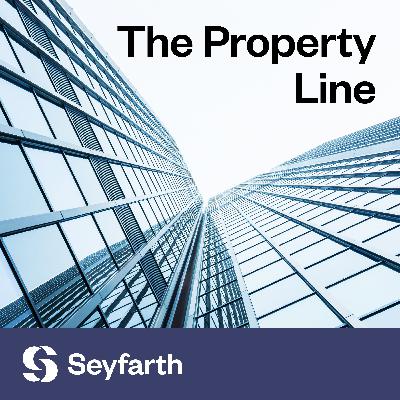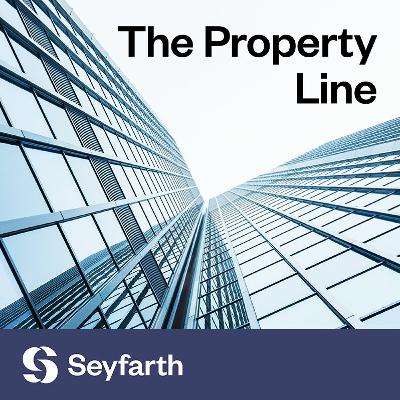Discover The Property Line
The Property Line

The Property Line
Author: Seyfarth Shaw LLP
Subscribed: 1Played: 41Subscribe
Share
© All rights reserved
Description
The Property Line is a brief and lively discussion of the biggest issues facing the commercial real estate industry. The podcast will deliver insights from Seyfarth’s real estate lawyers and other industry leaders on current market trends and how they impact all facets of commercial real estate.
75 Episodes
Reverse
Good Guy Guarantees are a longstanding feature of New York City leasing and are increasingly appearing in other markets. While designed to protect landlords against holdover risk, they are often misunderstood, particularly when it comes to the misconception that they provide tenants with an early termination right.
In this episode, Jason Polevoy, James O’Brien, and Eric Greenberg outline the fundamentals of Good Guy Guarantees, explore common pitfalls, and share practical drafting considerations for both landlords and tenants.
The One Big Beautiful Bill Act (OBBBA) is reshaping the tax landscape for real estate and, if you’re a sponsor, developer, or investor, it’s changing how you may approach deals. The biggest headlines: 100% bonus depreciation is back and permanent, unlocking year-one deductions and making cost segregation essential again; interest deductibility is easier, reducing the need for elections that previously limited depreciation; and the Opportunity Zone program is now permanent, with a map refresh in 2027 and new perks for rural areas.
In this episode, Matt Peurach joins James O’Brien and Eric Greenberg to discuss how OBBBA is transforming the way real estate capital stacks are built and what sponsors should do in terms of re-underwriting current and pipeline projects, revisiting shelved deals, and preparing for the upcoming OZ redesign.
Read the full transcript of this episode here: https://www.seyfarth.com/dir_docs/podcast_transcripts/ThePropertyLinePodcast_TheBigBeautifulBillUnlockedTurningTaxLawintoEnhancedRealEstateDealFlow.pdf
In today’s dynamic commercial real estate environment, loan servicers are playing an increasingly strategic role in balancing complex deal structures and evolving borrower expectations, with a growing focus on innovation. From multifaceted private equity transactions to portfolio-level SASB deals, servicing professionals are leveraging both expertise and creativity to meet the demands of a more sophisticated market. At the same time, advancements in AI, automation, and managing cybersecurity are creating new opportunities to enhance efficiency, transparency, data and information safety, and the overall borrower experience.
In this episode, Jan Sternin, senior vice president and managing director at Berkadia, joins Katie Schwarting, chair of Seyfarth’s Servicing & Special Servicing practice, to discuss current market trends, the transformative role of technology in servicing, and more.
Read the full transcript of the episode here: https://www.seyfarth.com/dir_docs/podcast_transcripts/ThePropertyLine_Rethinking_Servicing_Balancing_Innovation_and_Experience.pdf
Cold storage facilities play a critical role in preserving perishable goods like food and pharmaceuticals, but they come with unique legal and operational challenges. From the widespread use of ammonia-based refrigeration systems to complex lien issues, lenders and investors need to understand the risks and complications at hand in this specialized market.
In this episode, Mike Delaney joins Jay Wardlaw to discuss key considerations for cold storage investments including evolving REIT ownership structures, collateral protection strategies, and the impact of aging infrastructure on facility valuation.
Read the full transcript of this episode here: https://www.seyfarth.com/dir_docs/podcast_transcripts/ThePropertyLine_FreezerBurn.pdf
Debt funds are becoming more and more prevalent in commercial real estate finance, offering speed, flexibility, and creative structuring for complex or transitional deals. With traditional lenders pulling back and market conditions shifting, these funding sources can provide essential capital for acquisitions, redevelopments, and quick-close opportunities. However, they come with tradeoffs that borrowers need to carefully consider.
In this episode, Terry Carroll and Mike Dowley join Dan Evans to unpack when and why borrowers turn to debt funds, the risks and reputational considerations involved, and strategies for success.
Read the full transcript of this episode here: https://www.seyfarth.com/dir_docs/podcast_transcripts/ThePropertyLine_CreativeDealStructuringwithDebtFunds.pdf
With evolving tenant expectations, higher operating costs, and a growing focus on sustainability, commercial property owners and operators are increasingly turning to smart building technologies to improve performance and enhance the tenant experience. From wireless sensors to integrated tenant apps, these tools can drive down expenses, boost NOI, and reduce insurance premiums when implemented thoughtfully.
In this episode, Rob Murchison, CEO of Intelligent Buildings, and Devon Newton, vice president of property management at Stiles, join Arren Goldman, partner in Seyfarth’s Real Estate department, to discuss practical strategies for deploying PropTech including how data, automation, and cybersecurity can help future-proof assets and streamline property operations.
As demand for data centers continues to rise, access to reliable power has become one of the biggest challenges facing developers. Skyrocketing costs, lengthy grid connection delays, and increasing competition for energy resources are reshaping site selection and project feasibility across the United States. At the same time, new technologies and alternative energy strategies—such as on-site generation and energy-first site selection—are emerging to help operators navigate these constraints and rethink how data centers secure and manage their power needs.
In this episode, Jeff Zygler, founder and CEO of Active Infrastructure, and Shawn Cutter, co-founder of EnergiAcres, join hosts Denice Tokunaga, partner in Seyfarth’s Real Estate department, and Chris Cottrell, partner in Seyfarth’s Corporate department and leader of the firm’s Energy practice, to discuss the evolving landscape of energy infrastructure for data centers.
Read the full transcript of this episode here: https://www.seyfarth.com/dir_docs/podcast_transcripts/ThePropertyLine_PoweringProgress_OvercomingEnergyChallenges.pdf
Rooftop solar leases are gaining traction as a way for commercial property owners to generate passive income while utilizing unused roof space. With falling solar costs, rising electricity prices, and new state programs driving demand—particularly in the industrial sector—these long-term agreements can provide a steady revenue stream with no upfront costs, making them an attractive opportunity for property owners. However, correctly navigating lease structures, development timelines, and maintenance responsibilities is essential to avoiding pitfalls.
In this episode, Josh Newell, senior vice president of Project Delivery at SolarKal, joins Chris Palmese, partner in Seyfarth’s Real Estate department, to break down the key factors property owners need to consider before moving forward with a rooftop solar lease.
Read the full transcript of today's episode here: https://www.seyfarth.com/dir_docs/podcast_transcripts/ThePropertyLine_SolarRooftopLeases.pdf
In Seyfarth’s 10th annual Real Estate Market Sentiment Survey, commercial real estate executives express optimism for 2025, with 87% expecting a year of opportunity driven by improving market fundamentals and anticipated rate reductions. However, rising costs remain a significant concern, with respondents narrowing in on inflation, interest rates, and property insurance as factors that could drive up the cost of acquiring and operating real estate.
In this episode, Eric Greenberg and James O’Brien break down key findings from the survey, exploring market expectations, top challenges, surprising investment trends, and the expanding role of AI in real estate.
As market uncertainties continue into 2025, lenders are seeking ways to adjust to changing conditions and get back to business. While the office sector faces significant challenges with a sharp decline in property values, the multifamily sector is experiencing high demand and a large pool of equity ready to acquire assets.
In this episode, Mike Comparato, head of commercial real estate at Benefit Street Partners, joins John Domby and Dan Evans to discuss the current state of the commercial real estate market and forecast what lenders should expect in the near to mid-term.
At this year’s Real Estate Roundtable State of the Industry meeting, policymakers, economists, and industry leaders shared a generally positive outlook, with expectations of increased deal volume, a focus on data centers and infrastructure, and potential regulatory shifts under the new administration. However, concerns remain over inflation, high interest rates, and geopolitical risks, particularly regarding global trade disruptions and access to critical resources.
In this episode, James O’Brien joins Eric Greenberg to discuss key takeaways from the meeting, including emerging investment trends, the impact of economic policy changes, and challenges that could shape the real estate market in 2025.
The REIT industry is a major force in real estate, with public REITs holding approximately $2.5 trillion in assets and more than 170 million Americans invested in REITs. Despite difficult headwinds coming out of 2023, REITs have been on the rise in 2024, showing resilience in diverse sectors, including surprisingly positive performance in the office sector. REITs provide key insights into market trends and are an attractive option for investors seeking diversified portfolios.
In this episode, Abby McCarthy, senior vice president of investment affairs at Nareit, joins James O’Brien and Eric Greenberg to discuss the fundamentals of the REIT industry, factors driving REIT growth, and the potential for convergence in public and private real estate valuations.
The Build America Bureau at the US Department of Transportation recently expanded its credit programs, TIFIA and RRIF, to include real estate projects, broadening the scope of federal support for infrastructure development. Both programs provide substantial advantages for sponsors but come with specific requirements that may limit their applicability for certain projects, making it essential for potential applicants to fully understand eligibility criteria and the application processes.
In this episode, Dr. Morteza Farajian, executive director of the Build America Bureau, joins Ron Gart to explore this development, the opportunities it offers for applicable commercial real estate projects, and initial steps to begin the application process.
For related webinar recordings, FAQ documents, and additional resources, please visit the Build America Bureau website.
High interest rates, escalating costs, and rising vacancy rates have taken a toll on real estate assets, particularly in the office sector, with buildings in key markets selling at significant discounts. At the same time, refinancing options have become increasingly elusive. How can those interested in acquiring distressed assets capitalize on current market conditions?
In this episode, Jason DeJonker, partner in Seyfarth’s Corporate department and chair of the firm’s Restructuring & Insolvency practice, joins hosts Eric Greenberg and James O’Brien to discuss the process of buying distressed real estate, including initial best practices, key players, and opportunities to gain a competitive advantage.
As new technologies evolve, the risks of title and wire fraud continue to grow. To successfully navigate closing and funding processes, real estate professionals must stay informed and protect against current risk factors — doing so is crucial to ensure a smooth, safe, and secure closing.
In this episode, Adam Chaudhary, president of FundingShield LLC, joins Arren Goldman to explore the key drivers of title and wire fraud risk in today's market. Adam and Arren discuss how parties to a real estate transaction can protect themselves and mitigate against liability and losses, particularly with the rise of AI and related technology advancements.
Commercial Property Assessed Clean Energy (C-PACE) is a state-enabled financing solution designed to help building owners and developers obtain funds for energy-efficient improvements in new construction and existing commercial property buildings. With its affordable and accessible nature, C-PACE has established itself as a rapidly growing funding source over the last decade.
In this episode, Kate Cusack, managing director, head of production for Nuveen Green Capital, joins Dan Evans and Chris Palmese to define C-PACE and discuss the funding strategy’s use, role in the market, and future prospects.
Special purpose entities (SPEs) are frequently employed in commercial real estate transactions to mitigate bankruptcy risks associated with borrowers or their properties. To qualify as bankruptcy remote, these entities must meet specific requirements, such as appointing "independent directors" and "springing members." With the Corporate Transparency Act (CTA) now in effect, mandating the disclosure of beneficial owners, SPEs must ensure compliance to avoid severe penalties for non-reporting or false reporting.
In this episode, Cameron Weil and Dustin Lauermann join Jay Wardlaw to explore the intersection of the CTA and SPEs and discuss how those affected can ensure compliance.
Amidst a challenging office market and tempered growth in the industrial and life sciences sectors, the retail landscape stands resilient. As retailers, owners, developers, brokers, and other industry professionals gather for the International Council of Shopping Centers (ICSC) annual conference in Las Vegas, anticipation grows for revelations on the future trajectory of retail in 2024 and beyond.
In this episode, Greg Covey, senior managing director at Newmark, joins Eric Greenberg and James O’Brien to discuss the current state of retail, observed trends, and more.
As many states continue to ease regulations and the Food and Drug Administration considers moving cannabis to Schedule III, commercial real estate is increasingly buzzed with interest in properties for use by cannabis businesses, from agricultural land and warehouses to retail spaces. Despite this seemingly abundant opportunity, investors currently find themselves navigating the still murky waters of federal illegality.
In this episode, Stan Jutkowitz joins James O’Brien and Eric Greenberg to discuss the cannabis industry landscape, hurdles faced when securing and investing in suitable real estate, and risks and liabilities for owners leasing to cannabis businesses.
In Seyfarth’s 9th annual Real Estate Market Sentiment Survey, executives across the commercial real estate sector weigh in on their top concerns and investment priorities as they navigate a delicate balance between hope and caution, mindful of impacts stemming from potential rate adjustments, persistent scarcity in debt financing, the looming specter of an economic slowdown, new workplace norms, and a lack of consensus in real estate valuations.
In this episode, Ron Gart and James O’Brien join Eric Greenberg to discuss what they found to be most revealing from the results.








